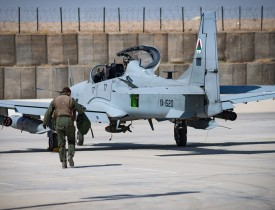AVA- According to a report by Pentagon Inspector General, the Afghan Air Force has made major progress in less than two years after flying its first combat mission usingthe A-29 Super Tucano aircraft.
The Afghans’ Super Tucano flew its first combat mission in April 2016. By March 2017, a U.S. brigadier general advising Afghan forces said he had seen a tenfold increase in support to his partner forces from A-29s over the past three months compared to the previous three months, according the report carried in a report Military Times newspaper.
The report further adds taht the success of the Afghan Air Force’s new light attack aircraft isn’t only measured by the amount of ordnance dropped, but also by how often they pull off target without engaging at all.
“Afghan A‑29 pilots aborted 18 percent of their attacks against identified targets due to concerns about civilian casualties, fratricide, or target identification,” according to data from April 14 through Dec. 31, 2016, provided by the commanding general of NATO Air Command-Afghanistan.
This comes as efforts are underway to further bolster the fighting capabilities of the Afghan national defense and security forces.
U.S. Air Force Brigadier General Lance Bunch, the director of the future operations, had earlier said that the Afghan forces conducted their combat operations through 2017 with the lowest level of support from the coalition forces in the 16-year war here, and yet has had some of the most success they’ve ever had, showing they are, in fact, leading the fight and we are there to advise and enable them.
He said “Key pieces that you’re seeing is that the Afghan Air Force itself, one of the more lethal organizations they have, and one that we’re looking to triple in size by 2023, is conducting significantly more air operations in direct support of the ANDSF on the battlefield, to the tune of 500 more sorties this year than they did the year before.”
“And so we are currently able to work with and enable the Afghan National Defense Forces as they conduct successful combat operations on the battlefield. We’re working with the Afghan Air Force to continue to build their capacity,” Gen. Bunch added.
According to Gen. Bunch, the first four UH-60 Black Hawks were delivered to the Afghan Air Force, and the first six pilots have already graduated from training.
“We expect to have eight full crews at the beginning of the fighting season in 2018. And those Black Hawk helicopters are just the first of up to 159 that we’re going to provide them,” he said.







